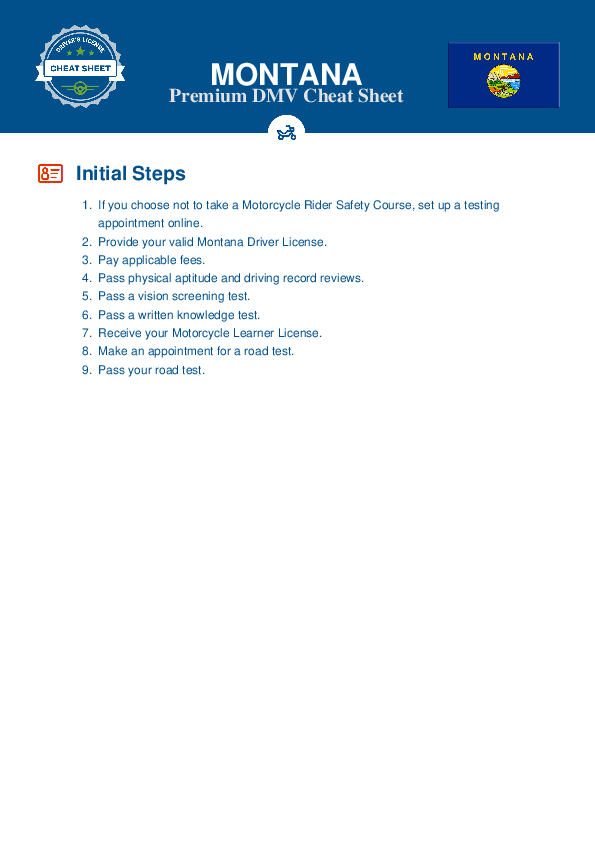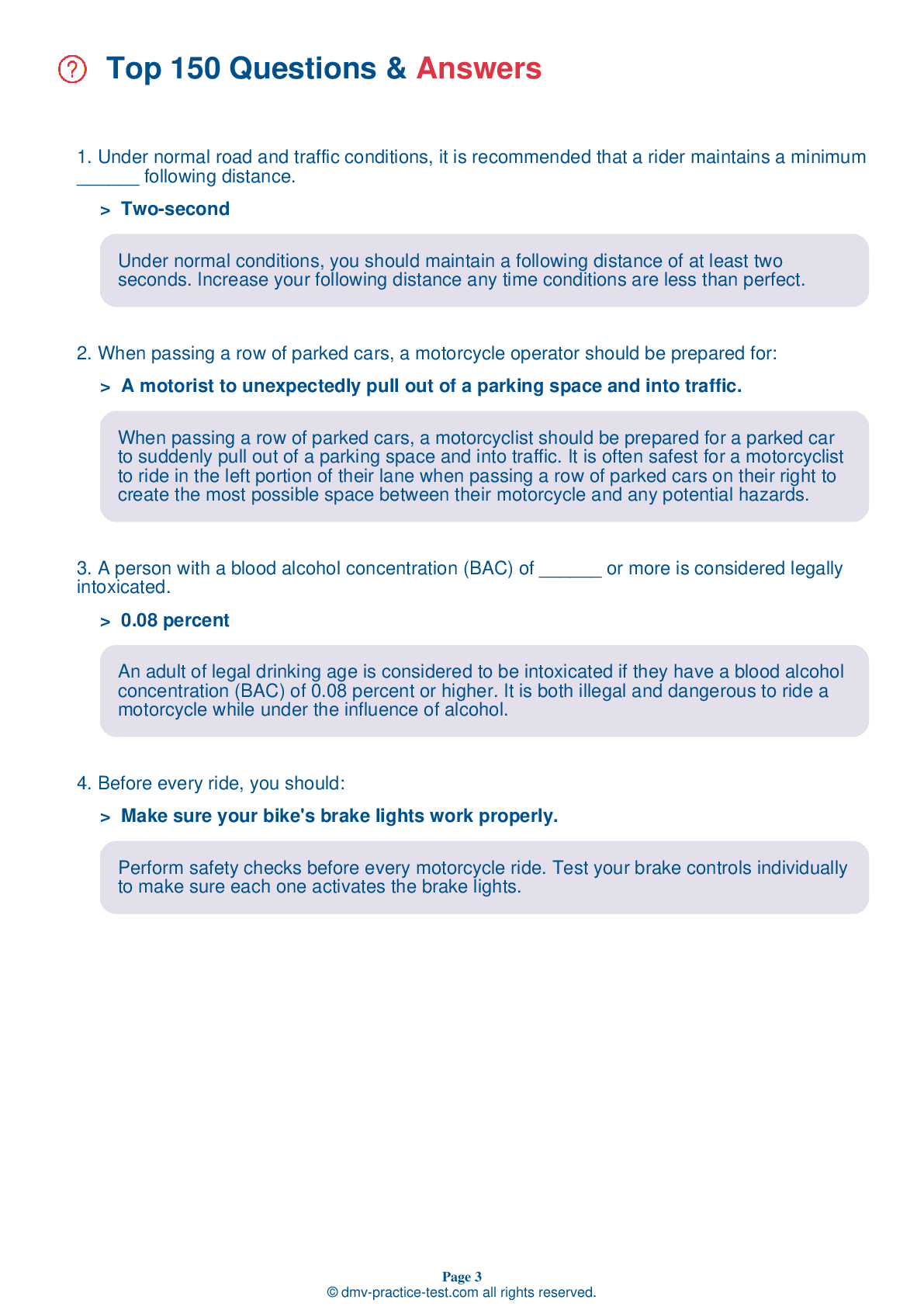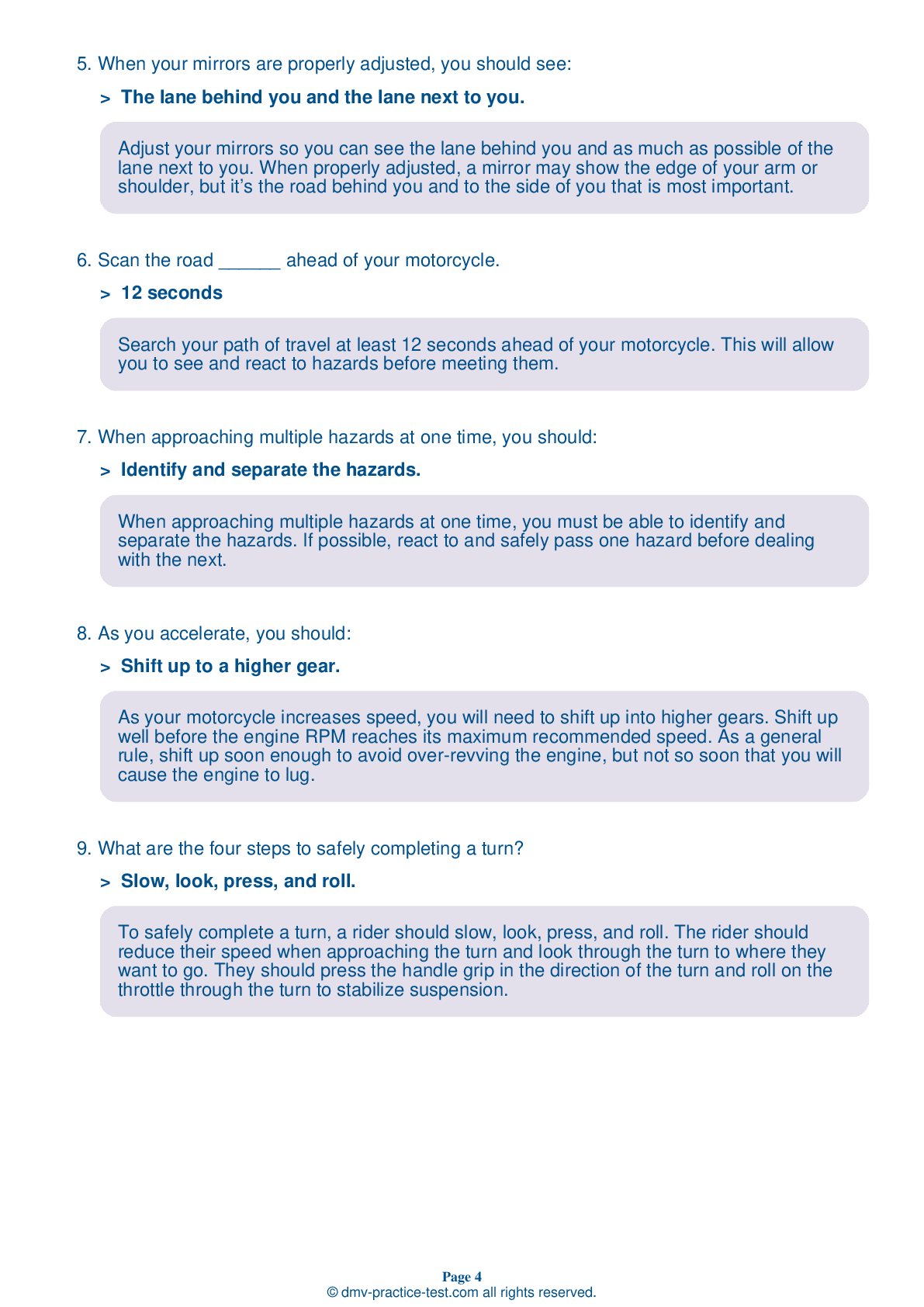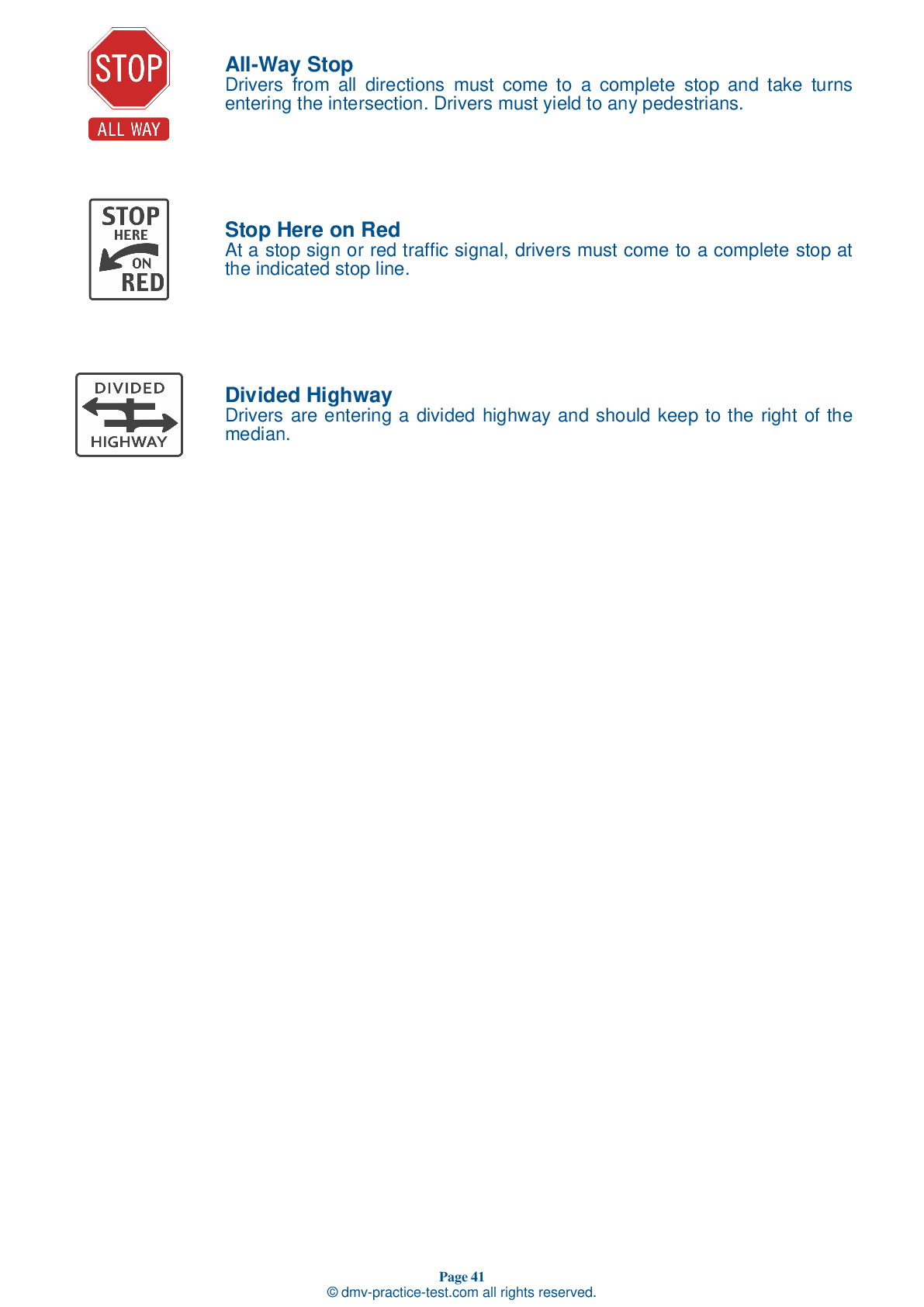DMV Permit Test #6
Motorcycle Test | License MT 2025 | FREE Online Practice! #6 Page 2 of 4
Take this FREE motorcycle test (license in MT 2025) to check your knowledge of the road rules. To improve your results, download a motorcycle handbook online, study theory, and practice for free on our website. Still worried about how to get a motorcycle license in Montana in 2025? Check our website for more sample tests, train as much as possible, and boost your grades!
25
20
16
7 . When passing a row of parked cars, a motorcycle operator should be prepared for:
Other motorists to see the motorcycle and stay out of its way.
When passing a row of parked cars, a motorcyclist should be prepared for a parked car to suddenly pull out of a parking space and into traffic. It is often safest for a motorcyclist to ride in the left portion of their lane when passing a row of parked cars on their right to create the most possible space between their motorcycle and any potential hazards.
8 . When riding a three-wheeled motorcycle through a curve, it is best to:
Use the shoulder.
The cornering characteristics of a three-wheeled motorcycle or a motorcycle with a sidecar differ from those of a two-wheeled motorcycle. The best path for a three-wheeler to take through a curve may not actually follow the curve. For example, you may need to move from the outside of the curve to the inside of the curve before straightening out your path.
9 . When riding, the best protection for an operator is:
A good understanding of motorcycle laws.
Your first and best protection against collisions with other vehicles is simply to keep your distance from them. The only way to be sure you will have enough time to react to mistakes made by other drivers is to leave plenty of space between you and the vehicles around you. Wearing proper gear is also important when riding a motorcycle.
10 . If you cannot see through the vehicle ahead of you, your following distance should be a minimum of:
Ten seconds.
An expanded cushion of space is needed if your motorcycle will take longer than normal to stop. If the pavement is slippery, if you cannot see through the vehicle ahead of you, or if traffic is heavy and another driver may try to squeeze in front of you, open up to a minimum three-second following distance.
11 . When carrying a passenger, you should:
Sit anywhere.
When transporting a passenger, you should be sure that you have a seat that is large enough to carry two people without crowding. You should not sit any farther forward than you usually do.
12 . When braking on a slippery surface, you should:
Not use any brakes, but downshift.
To ride safely on a slippery surface, you should reduce your speed and avoid making sudden moves. Use both brakes if you must slow down or stop.
Need Motorcycle Insurance? No problem!
Compare the best rates in Montana and find a personalized policy that meets your needs.
1. Are You Currently insured ?
2. Married ?
3. Do you own your Home?
4. Have you or a Family Member Honorably Served in U.S. Military ?
5. Your Name
6. Age
7. Zip code
Ranked by best match
2025 Montana | Frequently Asked Questions
In Montana, to obtain a motorcycle driver's license, you must first have a valid Montana driver's license. Then, you'll need to pass a written knowledge test and a skills test. Alternatively, you can complete an approved motorcycle safety course, which often waives the skills test requirement. After passing the necessary tests or course, you can apply for a motorcycle endorsement.
In Montana, the minimum age for obtaining a motorcycle endorsement is 15 years old. However, if you're under 18, you must first have a learner's license for six months, complete a state-approved driver's education course, and pass both a written and driving test. Additionally, those under 18 must have parental consent to get a motorcycle endorsement.
Yes, you do need a dedicated license for motorcycle riding in Montana. You can either apply for a standalone motorcycle license or a motorcycle endorsement if you already have a regular driver's license. To obtain this, you must pass both a written knowledge test and a skills test related to motorcycle operation.
To apply for a motorcycle driver's license in Montana, you'll need to provide several documents. These include proof of identity (like a birth certificate or passport), Social Security number, and Montana residency. If you're under 18, you'll also need parent or guardian consent. Lastly, if you've completed a motorcycle safety course, bring the certificate of completion.
Yes, you will need to take a written exam to get a motorcycle license in Montana. The written test is designed to assess your knowledge of Montana's traffic laws and safe riding techniques. It covers topics like handling dangerous surfaces, carrying passengers, and emergency situations. Passing the test is required before you can move on to the road skills test.
The motorcycle written test in Montana covers a variety of topics related to motorcycle safety and operation. These include traffic laws, road signs, safe riding techniques, handling dangerous situations, and effects of alcohol and drugs on riding. The questions are based on the information in the Montana Motorcycle Supplement.
In Montana, completing an approved motorcycle safety course can waive both the written and skills tests required for a motorcycle endorsement. You must pass the course within a year of your application date. After completion, present the certificate to the Motor Vehicle Division. However, this doesn't apply to first-time drivers who must take the standard written test.
To enroll in a motorcycle training course in Montana, you should first locate an approved provider, such as the Montana Motorcycle Rider Safety (MMRS) course. You can sign up online or by phone. The course typically includes classroom instruction and practical skills training. Upon completion, you may be exempt from the state's motorcycle skills test requirement.
No, you don't necessarily need to own a motorcycle to take the license test in Montana. You can use a borrowed motorcycle as long as it is registered, insured, and meets all safety standards. However, you must be able to handle and control the motorcycle you use during the skills test.
Yes, you can use a friend's motorcycle for the driver's license evaluation in Montana. However, the motorcycle must be legally registered, insured, and meet all safety requirements. You should also have written permission from the owner if you're not insured to ride it. It's crucial to ensure you can safely handle the motorcycle during the test.
Yes, in Montana, the motorcycle driving exam tests specific handling skills. These include your ability to start and stop, turn and swerve, and navigate through traffic. You'll also be assessed on your knowledge of road signs, signals, and rules. Proper gear usage and understanding of safety protocols are also evaluated during the test.
In Montana, new motorcycle drivers who have a learner's license must follow certain restrictions. They are not allowed to ride from sunset to sunrise, carry passengers, or operate their motorcycle on interstate highways. These restrictions are lifted once the driver obtains a full 'M' endorsement on their driver's license.
Yes, your Montana motorcycle license allows you to ride a motorcycle out of state. This is due to the Full Faith and Credit Clause of the U.S. Constitution, which requires each state to honor the public acts, records, and judicial proceedings of every other state. However, you must abide by the traffic laws of the state you are in.
In Montana, motorcycle helmet laws depend on the age of the rider. Riders under 18 years old are required by law to wear a helmet when operating a motorcycle. However, riders aged 18 and over are not legally obligated to wear a helmet. Despite this, it is highly recommended for safety reasons that all riders wear a helmet.
In Montana, there's primarily one type of motorcycle license, which is the 'M' endorsement added to your existing driver's license. This allows you to operate motorcycles on public roads. However, there's also a motorcycle learner's license for beginners who are learning to ride. This has certain restrictions and is only valid for a specific period.
Yes, in Montana, you can add supplementary endorsements to your motorcycle license. For instance, you can add a sidecar/trike endorsement if you pass the necessary tests. Each endorsement allows you to operate different types of motorcycles. Remember, additional endorsements may require separate applications, fees, and exams. Always check with the Montana MVD for specific requirements.
Yes, the Montana motorcycle license test can be taken in several languages other than English. This is to accommodate diverse linguistic groups. However, you should contact your local Montana Department of Justice's Motor Vehicle Division office in advance to confirm the availability of your preferred language for the test.
To effectively prepare for the motorcycle license test in Montana, start by studying the Montana Motorcycle Supplement thoroughly. This guide covers all the knowledge you'll need for the test. Practice with online mock tests to familiarize yourself with the exam format. Additionally, take a motorcycle safety course to gain practical knowledge and skills.
In Montana, the motorcycle written exam is primarily administered in English. However, if you need assistance due to language barriers, it's recommended to contact the Montana Motor Vehicle Division directly. They may be able to provide additional resources or arrange for an interpreter to assist during the exam.
If you don't pass the motorcycle written test in Montana, you can retake it. However, you must wait for a period of one day before attempting the test again. It's advisable to use this time to review and study the areas you struggled with during the initial test to increase your chances of passing on the next attempt.



